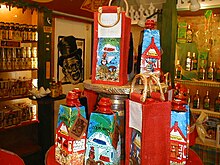Myrciaria floribunda
| Myrciaria floribunda | |
|---|---|

| |
| Scientific classification | |
| Kingdom: | Plantae |
| Clade: | Tracheophytes |
| Clade: | Angiosperms |
| Clade: | Eudicots |
| Clade: | Rosids |
| Order: | Myrtales |
| Family: | Myrtaceae |
| Genus: | Myrciaria |
| Species: | M. floribunda
|
| Binomial name | |
| Myrciaria floribunda (H.West ex Willd.) O.Berg
| |
| Synonyms[2] | |
|
Expand list
| |
Myrciaria floribunda, commonly known as cambuizeiro, guavaberry or rumberry, is a species of plant in the family Myrtaceae. It can be found across South and Central America and the West Indies in dry or moist coastal woodlands, up to 300 metres above sea level.[3] The guavaberry, which should not be confused with the guava, is a close relative of camu camu.
Description
[edit]
Guavaberry trees are slow growing and can reach 12–20 metres (39–66 ft) tall.[3] They have red-brown branches and small pink and white flowers. The fruit, which are roughly half the size of cherries, are yellow-orange, dark-red, or purple with tanginess of a guava containing a small amount of translucent flesh surrounding a stone. The fruit has moderate sweetness.[4] The fruit is rich in vitamin C, with the darker colored fruit having higher concentrations.[5]
There is great genetic variability within the species, and Myrciaria floribunda can vary in form, structure and appearance, and that has given rise to a large number of botanical synonyms.[6][7]
Distribution
[edit]Guavaberry trees can be found growing wild in Central America, South America, Argentina, Belize, Bolivia, Brazil, Colombia, Costa Rica, and many Caribbean islands. The guavaberry has also been introduced to Florida, Hawaii, Bermuda, Philippines, and Tanzania.[8][4]
Uses
[edit]
Guavaberry is used to make jams and drinks. Guavaberry liqueur, which is made from rum, is a common Christmas drink on many of the islands, particularly in Sint Maarten and the Virgin Islands.[4] The colonists from Denmark and Holland found it could flavor rum by infusion similar to infused schnapps.[9] In the Dominican Republic it is associated with the eastern town of San Pedro de Macorís which has a large population of Eastern Caribbean descent.[10]
Guavaberry coquito is one of many coquito flavored drinks from Puerto Rico associated with Christmas. The drink is made with spices, guavaberry, milk, sugar, coconut milk, eggs, and rum.[citation needed]
References
[edit]- ^ Botanic Gardens Conservation International (BGCI), IUCN SSC Global Tree Specialist Group; Lorea Hernández, F. (2019). "Myrciaria floribunda". IUCN Red List of Threatened Species. 2019: e.T136783953A136783955. doi:10.2305/IUCN.UK.2019-2.RLTS.T136783953A136783955.en. Retrieved 13 December 2022.
- ^ "Myrciaria floribunda (H.West ex Willd.) O.Berg". The Plant List. Retrieved January 16, 2021.
- ^ a b "Myrciaria floribunda:(H.West. ex Willd.) O.Berg". Useful Tropical Plants. Retrieved January 16, 2021.
- ^ a b c "Myrciaria floribunda, Eugenia floribunda". toptropicals.com. Retrieved January 16, 2021.
- ^ Rezende Pinheiro, Lucas; Almeida, C. S.; da Silva, A. V. C. (2011). "Diversidade genética de uma população natural de cambuizeiro e avaliação pós-colheita de seus frutos". Scientia Plena (in Portuguese). 7 (6).
- ^ Veruska Cruz Silva, Ana; Letícia Sirqueira Nascimento, Ana; Neves Muniz, Evandro (2020). "Fruiting and quality attributes of cambui (Myrciaria floribunda (West ex Willd.) O. Berg in the Atlantic Forest of northeast Brazil". Revista Agro@Mbiente On-Line. 14. doi:10.18227/1982-8470ragro.v14i0.5861.
- ^ Villaron Franceschinelli, Edivani; Mara Patr´ıcio Vasconcelos, Giuliana; Charlotte Landau, Elena; Yukari Ono, K´atia; Antonio Maes Santos, Fl´avio (2007). "The genetic diversity of Myrciaria floribunda (Myrtaceae) in Atlantic Forest fragments of different sizes". Journal of Tropical Ecology. 23 (3). Cambridge University Press: 361–367. doi:10.1017/S0266467407004099.
- ^ "Myrciaria floribunda (H.West ex Willd.) O.Berg". Plants of the World Online. Kew Science. Retrieved January 16, 2021.
- ^ Julia F. Morton (1987). Fruits of Warm Climates. J.F. Morton. pp. 388–390. ISBN 0-9610184-1-0. Retrieved January 16, 2021.
- ^ "Guavaberry Drink and Jam - Cocolo Culture". Retrieved January 16, 2021.

